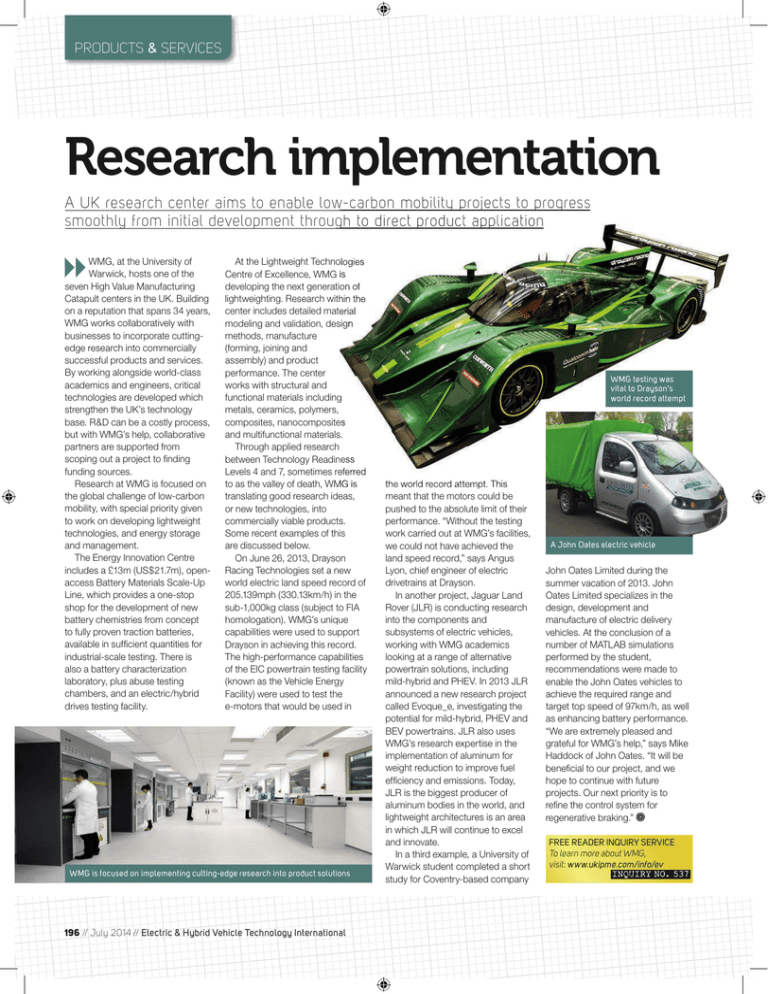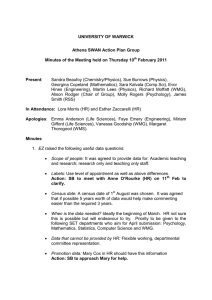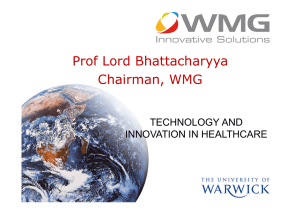Research implementation PRODUCTS & SERVICES
advertisement

PRODUCTS & SERVICES Research implementation A UK research center aims to enable low-carbon mobility projects to progress smoothly from initial development through to direct product application WMG, at the University of Warwick, hosts one of the seven High Value Manufacturing Catapult centers in the UK. Building on a reputation that spans 34 years, WMG works collaboratively with businesses to incorporate cuttingedge research into commercially successful products and services. By working alongside world-class academics and engineers, critical technologies are developed which strengthen the UK’s technology base. R&D can be a costly process, but with WMG’s help, collaborative partners are supported from scoping out a project to finding funding sources. Research at WMG is focused on the global challenge of low-carbon mobility, with special priority given to work on developing lightweight technologies, and energy storage and management. The Energy Innovation Centre includes a £13m (US$21.7m), openaccess Battery Materials Scale-Up Line, which provides a one-stop shop for the development of new battery chemistries from concept to fully proven traction batteries, available in sufficient quantities for industrial-scale testing. There is also a battery characterization laboratory, plus abuse testing chambers, and an electric/hybrid drives testing facility. At the Lightweight Technologies Centre of Excellence, WMG is developing the next generation of lightweighting. Research within the center includes detailed material modeling and validation, design methods, manufacture (forming, joining and assembly) and product performance. The center works with structural and functional materials including metals, ceramics, polymers, composites, nanocomposites and multifunctional materials. Through applied research between Technology Readiness Levels 4 and 7, sometimes referred to as the valley of death, WMG is translating good research ideas, or new technologies, into commercially viable products. Some recent examples of this are discussed below. On June 26, 2013, Drayson Racing Technologies set a new world electric land speed record of 205.139mph (330.13km/h) in the sub-1,000kg class (subject to FIA homologation). WMG’s unique capabilities were used to support Drayson in achieving this record. The high-performance capabilities of the EIC powertrain testing facility (known as the Vehicle Energy Facility) were used to test the e-motors that would be used in WMG is focused on implementing cutting-edge research into product solutions 196 // July 2014 // Electric & Hybrid Vehicle Technology International WMG testing was vital to Drayson’s world record attempt the world record attempt. This meant that the motors could be pushed to the absolute limit of their performance. “Without the testing work carried out at WMG’s facilities, we could not have achieved the land speed record,” says Angus Lyon, chief engineer of electric drivetrains at Drayson. In another project, Jaguar Land Rover (JLR) is conducting research into the components and subsystems of electric vehicles, working with WMG academics looking at a range of alternative powertrain solutions, including mild-hybrid and PHEV. In 2013 JLR announced a new research project called Evoque_e, investigating the potential for mild-hybrid, PHEV and BEV powertrains. JLR also uses WMG’s research expertise in the implementation of aluminum for weight reduction to improve fuel efficiency and emissions. Today, JLR is the biggest producer of aluminum bodies in the world, and lightweight architectures is an area in which JLR will continue to excel and innovate. In a third example, a University of Warwick student completed a short study for Coventry-based company A John Oates electric vehicle John Oates Limited during the summer vacation of 2013. John Oates Limited specializes in the design, development and manufacture of electric delivery vehicles. At the conclusion of a number of MATLAB simulations performed by the student, recommendations were made to enable the John Oates vehicles to achieve the required range and target top speed of 97km/h, as well as enhancing battery performance. “We are extremely pleased and grateful for WMG’s help,” says Mike Haddock of John Oates. “It will be beneficial to our project, and we hope to continue with future projects. Our next priority is to refine the control system for regenerative braking.” FREE READER INQUIRY SERVICE To learn more about WMG, visit: www.ukipme.com/info/ev INQUIRY NO. 537

